Site-specific protein labeling via sortase A and its applications/
Author(s)
Popp, Maximilian Wei-Lin
DownloadFull printable version (45.39Mb)
Other Contributors
Massachusetts Institute of Technology. Dept. of Biology.
Advisor
Hidde L. Ploegh.
Terms of use
Metadata
Show full item recordAbstract
Technological improvements in the assays and equipment used for biological, biochemical, biophysical and microscopy purposes have ensured that methods for labeling of proteins with reporter molecules remain in high demand. Standard chemical labeling methods using entities that react with amino acid side chains lack the specificity to ensure precise placement of reporter groups. Genetic methods, although specific, lack the versatility afforded by chemical synthesis-most reporters are limited to protein sized domains or peptide tags to which corresponding antibody based reagents are available. The first portion of this work is devoted to the establishment of a system that allows for the site-specific labeling of proteins with a wide variety of chemically synthesized probes. This system exploits sortases, a class of bacterial transpeptidases, that recognize a small five amino acid tag genetically fused to the protein of interest and catalyze the formation of an amide bond between the protein to be studied and the probe. The second part of this thesis describes how this sortase mediated protein labeling method has been implemented to explore enzyme structure and function, improve the physical properties of therapeutic proteins, study glycoproteins important for innate immune responses in living cells (Appendix A), and visualize influenza glycoproteins in living, infected cells. Finally, a protocol is included for this system (Appendix B), which is both versatile and easy to establish in any lab. The synthetic chemistry demanded is minimal, requiring only standard, readily available reagents, making the system amenable to labs equipped for cell and molecular biology experiments.
Description
Thesis (Ph. D.)--Massachusetts Institute of Technology, Dept. of Biology, 2011. Cataloged from PDF version of thesis. Includes bibliographical references.
Date issued
2011Department
Massachusetts Institute of Technology. Department of BiologyPublisher
Massachusetts Institute of Technology
Keywords
Biology.